
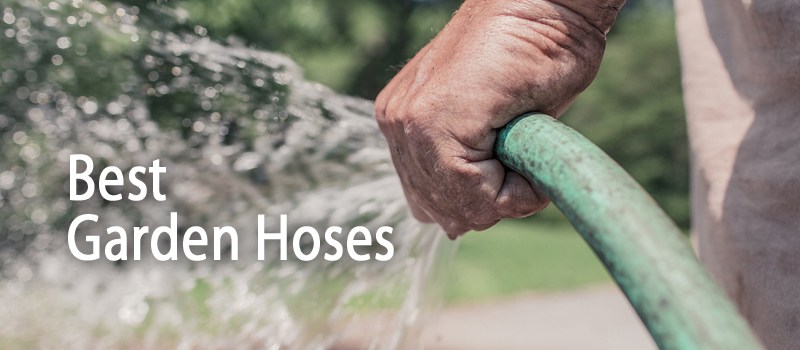
UPDATED March 16, 2016
With so many options to choose from and little visible difference between garden hoses, it’s tempting to simply choose the cheapest one. But small differences can have a big impact on how long the hose lasts and how easy it is to use.
A good garden hose should last 5 to 10 years. But many homeowners who buy lower quality hoses end up replacing theirs each year due to leaks, cracks or rot. Although some problems can be repaired, it’s generally more cost-effective to buy a good quality hose to begin with.
In this article, we review the features to consider when buying a new garden hose so that you’ll know what to look for in choosing a quality product.
If you’re just interested in the different types of hoses and our recommendations for the best garden hose, scroll down to Types of Hoses.
How to Choose the Best Garden Hose for You
There isn’t just one kind of garden hose that’s perfect for everyone. What works best for you will depend on the size of the area in which you’ll be using it, what you’ll use the hose for and where you’ll store it, as well as your budget. But, in general, there are six things you should consider when choosing a garden hose.
Important Considerations When Buying a Garden Hose
1. Length – Longer is Not Better
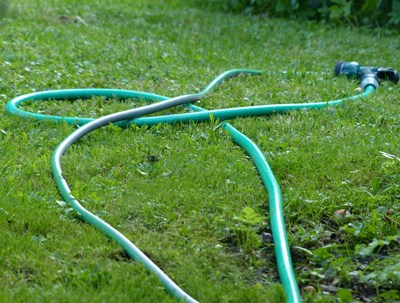
Only buy the length you need, no longer
Garden hoses come in 25-, 50-, 75- and 100-foot lengths. It’s tempting to buy one longer hose and use it for all of your watering needs around the garden. But don’t do it. Not only do longer hoses cost more, but they’re heavier to move around, need more storage space, can be difficult to drain before putting them away for the winter, and can result in lower water pressure coming out the end.
Measure the farthest distance from your spigot and buy a hose that goes just beyond that. You don’t want to tug on the hose to stretch it out as that’s likely to cause snags or leaks.
On a deck or balcony, a 25-foot garden hose is usually fine. Most urban yards need only a 50-foot hose, at most. If you need a longer length of hose than 50 feet, consider buying two hoses and joining them together when you need to go beyond 50 feet. That way you’re not lugging around a long, heavy garden hose all the time.
2. Hose Diameter – Width = Water Flow
The most common garden hose diameters are ¾ inch, five-eighths inch and half inch. These measurements are based on the inside diameter of the hose, not the outside. The bigger the diameter, the more water the hose will carry.
A hose width of five-eighths inch is generally most useful. It’s a good combination of water flow and pressure without being too heavy.
If hose weight is an issue for you, a half-inch hose may be best. They tend to be lighter weight but because of the smaller diameter they don’t carry as much water. Half-inch garden hoses are best kept to 50 feet or less and used for light-duty gardening tasks, such as watering containers and hanging baskets. These hoses are not appropriate for use with sprinklers or anything that requires higher water pressure (like washing your car).
3. Material – Rubber is Best
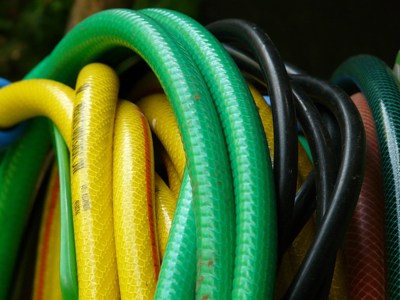
Garden hoses come in a range of colors and materials
You’ll commonly find garden hoses made of rubber, vinyl, or a combination of the two.
A basic vinyl hose (usually reinforced with a radial cord) is the least expensive and most lightweight option but also the least sturdy. It’s more prone to kinking, splitting and cracking than other materials and can degrade quickly if left in the sun or exposed to harsh weather. But if budget is an issue and you’ll only be using the hose for light duty gardening tasks, then a vinyl garden hose can be a good option.
Rubber hoses are generally the strongest and most long-lasting, but also carry the highest price tag and can be heavy to haul around the garden. Rubber has the added benefits of being able to carry hot water, being less likely to kink, and resisting cracking and ozone deterioration (so they don’t fall apart if left in the sun). For heavy duty use and a hose that lasts through many seasons, rubber is the best choice.
A middle-of-the-road option is a composite rubber/vinyl garden hose.
Reinforced hoses (usually reinforced with a mesh lining between layers of vinyl and/or rubber) are more resistant to kinking and splitting, and can take higher water pressure levels.
Although additional layers (or “plies”) tend to suggest a stronger hose, don’t put too much stock in this figure—the number of layers doesn’t matter as much as what those layers are made from. A strengthening “mesh” layer is a good sign, other things being equal.
Be careful with both rubber and vinyl garden hoses as they leach chemicals into the water than make it unsafe to drink. If you or your pets will be drinking from the hose, invest in a “drinking water safe” hose. These are generally made from polyurethane and have been specially built so as not to leach harmful chemicals.
4. Strength – Look at Burst Pressure
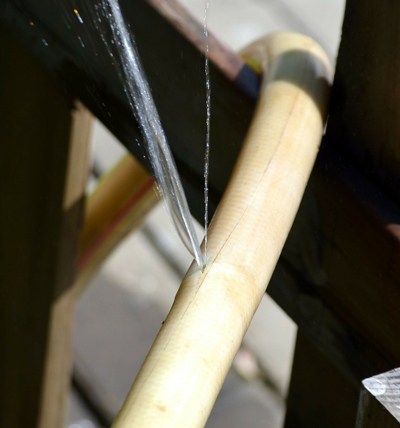
Some types of hoses are more prone to rupture than others. Be sure to buy one with the right burst pressure rating.
Garden hose strength can be measured in terms of “burst pressure” (the water pressure at which it is likely to rupture). If you’ll be using a hose nozzle or a sprinkler, look for a hose with a burst pressure above 350 psi. For pressure washer use, check your manual before buying a hose – you may need an even higher psi.
5. Flexibility – Try the Kink Test
You want a garden hose that’s flexible (for easy storage, going around corners, etc.) but not so flexible that it kinks easily. Kinking leads to splitting and shortens the life of your hose. While all garden hoses will kink if twisted (yes, even the “kink-free” hoses), some are better than others. In general, reinforced and rubber hoses are less likely to kink than other kinds.
When shopping for a garden hose, bend it into a U. If it kinks, pick another.
6. Couplings – Look For Cast Brass
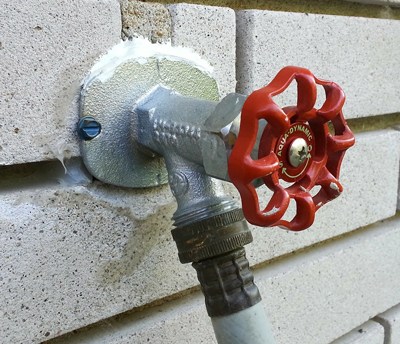
Stamped metal (like the coupling shown here) is usually not the best choice.
Garden hose couplings are the end pieces that attach to spigots, sprinklers and nozzles.
Less expensive hoses often have plastic couplings. Avoid these – they’re more prone to leaks, cracks and breakage and often can’t be tightened properly. Plastic also breaks down quickly, particularly when left in the sun.
Metal couplings (usually brass, although many are chrome plated) are either stamped or cast. You can identify cast brass because it’s thicker than sheet metal and usually has an octagonal shape so that the coupling can be turned with a wrench. Couplings made from cast brass are the most durable and leak-resistant. Thin stamped-metal fittings can be difficult to tighten at the spigot, bend easily (so don’t step on it or run over it with the lawnmower or car), and break down over time.
All else being equal, a large octagon-shaped coupling is easiest to tighten, particularly for those of us with stiff fingers or lower grip strength.
While many hoses come with a washer inserted into the coupling, these are often thin plastic washers that quickly break down. We always recommend that you use a high quality rubber washer (such as this one from Gilmour) at the connection point between the hose fitting and the spigot or nozzle. This will help prevent leaks.
Look for a collar. Quality hoses often have a plastic or rubber “collar” extending perhaps four to six inches up the hose from one coupling. This reduces the odds of a kink or split near the spigot, where they are particularly common.
Types of Garden Hoses
Below are descriptions of the most common types of garden hoses, along with our recommendations. Hover over each product name or image for pricing details.
Lightweight / Light Duty Hoses
These hoses are generally made from vinyl (sometimes with a reinforcing mesh or multiple plies (layers)) so can kink more easily, often have plastic fittings, and tend to come in thinner diameters but prices are in the lower range.
If you’re gardening on a budget, won’t be using it often, don’t need a long hose (over 50 feet), and have lower water pressure or don’t use a sprinkler or hose nozzle, then a lightweight hose will probably meet your needs.
While you can find light duty hoses online, your best bet is to visit your local home improvement store or garden center. You’ll find some of the heavier duty hoses there as well, but many of them are perfect for light duty use.
Regular and Heavy Duty Hoses
 Dramm 17006 ColorStorm Premium 50-Foot-by-5/8-Inch Rubber Garden Hose, Berry
Dramm 17006 ColorStorm Premium 50-Foot-by-5/8-Inch Rubber Garden Hose, Berry
>> This tough rubber hose stands up to the elements (mine has been out in the sun for 2 years). Available in 6 fun colors!
 Briggs and Stratton 8BS50 50-Foot Premium Heavy-Duty Rubber Garden Hose
Briggs and Stratton 8BS50 50-Foot Premium Heavy-Duty Rubber Garden Hose
>> Thick rubber with nickel-plated brass couplings. Stays flexible in very cold weather and can be used with hot water up to 200F. Made in the USA.
 Scotts SMF58050CC MaxFlex Premium Heavy Duty Garden Hose, 5/8-Inch by 50-Feet, Green
Scotts SMF58050CC MaxFlex Premium Heavy Duty Garden Hose, 5/8-Inch by 50-Feet, Green
>> Lead-free for safe drinking, with heavy-duty aluminum couplings, reinforcement at the spigot end, and a 500psi burst strength. Features ‘Lay-Flat technology’ to resist kinking.
 NeverKink 8844-50 Series 4000 Commercial Duty Pro Garden Hose, 5/8-Inch by 50-Feet
NeverKink 8844-50 Series 4000 Commercial Duty Pro Garden Hose, 5/8-Inch by 50-Feet
>>The company guarantees this hose not to kink. Has a coiled collar at the spigot end, lead-free aluminum couplings, and an anti-microbial to prevent build-up of mold and mildew. Stays flexible down to 45 degrees. Made in USA.
 Tuff-Guard The Perfect Garden Hose, Kink Proof Garden Hose, 5/8-Inch by 50 Feet
Tuff-Guard The Perfect Garden Hose, Kink Proof Garden Hose, 5/8-Inch by 50 Feet
>> This hose has a unique polypropylene double helix coil around the hose’s exterior to give it stability. It’s flexible but kink-free. 300 psi burst pressure. Machined brass couplings.
 Gilmour 10058050 8-ply Flexogen Hose, 5/8-Inch by 50 Feet
Gilmour 10058050 8-ply Flexogen Hose, 5/8-Inch by 50 Feet
>> With a lifetime replacement guarantee, this hose stays flexible at temperatures below freezing, has brass couplings and a collar, and a 500 psi burst strength rating.
Flat Hoses
Flat garden hoses are similar to a fireman’s hose; they’re round when full of water but flatten down when empty. They’re generally lightweight, easy to roll up (they’re self-draining) and take less storage space than a conventional hose, but can be difficult to store without a hose reel.
Some flat hoses are sold with a hose reel but for ones that aren’t, check that they will fit with your existing reel (or the one you’re considering buying).
Because they’re very flexible (so that they can flatten out), flat garden hoses are generally made of vinyl, puncture and kink more easily and have a lower burst pressure rating. They also don’t work very well when pulled around corners. Plus, you have to unroll the entire hose before turning on the water.
Flat garden hoses are best used when storage space is an issue and the hose will be used in a straight line over a surface without many snags. In general, these are not the best choice for frequent use in the garden and there are none that we recommend for that purpose.
Soaker Hoses
Soaker hoses are typically used for garden irrigation. These hoses are often made of recycled rubber and plastics and have porous walls. When the water is turned on, it oozes out through thousands of tiny holes in the hose, letting water seep out into or onto the surrounding soil.
Soaker hoses can either be laid directly on the ground (preferably below a layer of mulch), buried just under the surface, or even buried 6 or more inches deep (this is commonly done in large vegetable beds).
Soaker hoses come in a variety of diameters and lengths, from ¼-inch (these typically are part of a drip irrigation system and can be cut to length) to ¾-inch (these are the large black hoses you often see in garden centers). The larger hoses can be difficult to handle as they’re not very flexible. Use garden stakes to hold them in place and let them lie in the sun for a while to “soften up” before laying them in the garden.
Soaker hoses are best for relatively level sites and shorter lengths (although ¼ soaker hose can be effective for up to about 100 feet). If you’re using a large diameter soaker hose you’ll need decent water pressure to ensure that water seeps out along the entire length of the hose.
 Dramm 17010 ColorStorm Premium 50-Foot-by-5/8-Inch Soaker Garden Hose, Black
Dramm 17010 ColorStorm Premium 50-Foot-by-5/8-Inch Soaker Garden Hose, Black
>> Made from recycled material with nickel-plated brass fittings and extra thick walls to minimize spurting. Has a lifetime guarantee. >> Read our review!
 Miracle Gro MGSPA38050FM Premium Soaker Hose with Fittings, 3/8-Inch by 50-Feet
Miracle Gro MGSPA38050FM Premium Soaker Hose with Fittings, 3/8-Inch by 50-Feet
>> This hose has no attached couplings. Instead, you cut it to the desired length and insert the provided friction-fit, plastic male and female fittings. With two of each, you can even cut this into two separate hoses.
 MELNOR Flat Soaker Hose, 25-Feet
MELNOR Flat Soaker Hose, 25-Feet
>> This flat soaker hose is made from a woven/mesh material and has plastic couplings. It’s not a hose that you’d bury but it’s more flexible than a rubber soaker and works well with low water pressure.
 Gilmour 270050G Weeper/Soaker Hose, 50-Foot
Gilmour 270050G Weeper/Soaker Hose, 50-Foot
>> Made from a perforated PVC liner which is covered in fabric, the Gilmour hose is best used with lower water pressure (under 60 psi). Note that it seems to be almost identical to the Melnor flat soaker.
 Apex 1030-100 Soil Soaking Hose, 100-Feet
Apex 1030-100 Soil Soaking Hose, 100-Feet
>> Unlike most soaker hoses, this one is made from vinyl for better flexibility. Available in a 25′, 50′, 75′ and 100′ lengths. Made in the USA.
 Snip-n-Drip Soaker Hose System
Snip-n-Drip Soaker Hose System
>> These 1/2-inch hoses are easily customizable to meet your irrigation needs – just cut pieces to length and connect. Includes 50′ of 1/2″ soaker hose, 25′ of 1/2″ garden hose, 1 faucet adapter, 1 quick-connect coupler, 8 hose couplers and an end cap. From Gardener’s Supply.
 Raindrip 015005T 1/4-Inch by 50-Feet Porous Soaker Tubing
Raindrip 015005T 1/4-Inch by 50-Feet Porous Soaker Tubing
>> This 1/4-inch porous tubing is typically used as part of a drip irrigation system. You’ll need to buy 1/4-inch barbed fittings and provide a 1/2-inch or larger water supply line, but it’s an efficient way to water and easy to set up.
Orbit DripMaster 65731 1/2-Inch to 5/8-Inch Loop Stake, 10-Pack
>> If you lay your soaker hose on the ground or under mulch, you’ll need these to anchor your soaker hose to the ground.
Drinking Water Safe Hoses
If you or your pets will be drinking from the hose or if you’re using it to fill a pool that will be used by children, make sure that your garden hose doesn’t leach harmful chemicals.
Most garden hoses are made with materials like plasticizers that give the hose flexibility but also contain chemicals, like BPA, lead and phthalates, that find their way into the water in the hose. While these chemicals don’t harm your plants, they are toxic for humans.
Look for hoses labeled “drinking water safe” or at least “lead free” – you’ll often find them sold for recreational use, such as for use in boats and RVs. These hoses are made with non-toxic, FDA-approved inner cores that don’t leach harmful chemicals.
And let water run through the hose until it’s cold before watering your vegetables or other edibles (chemicals leach from the hose and concentrate in the water as it heats up inside a hose that’s been left in the sun).
 Camco 22853 Premium Drinking Water Hose (5/8″ID x 50′)
Camco 22853 Premium Drinking Water Hose (5/8″ID x 50′)
>> 20 percent thicker than standard drinking water hoses and leaves no strong plastic taste in your drinking water. Machined nickel-plated brass fittings and strain-relief ends for added durability. Made in USA.
 Water Right PSH-050-MG-4PKRS Polyurethane Lead Safe Ultra-Light Slim Garden Hose, 50-Foot x 7/16-Inch, Olive Green
Water Right PSH-050-MG-4PKRS Polyurethane Lead Safe Ultra-Light Slim Garden Hose, 50-Foot x 7/16-Inch, Olive Green
>> Chrome-plated machined brass fittings with collars on both hose ends. 7/16-inch inside diameter handles 4-5 gallons per minute flow rate, although this is less than the typical 5/8″ hose. Comes in four colors. Made in USA.
 Plastair Marine/RV SpringHose PUWE625B9-M-3-AMZ 25-foot 3/8-inch Drinking Safe Water Hose, Blue
Plastair Marine/RV SpringHose PUWE625B9-M-3-AMZ 25-foot 3/8-inch Drinking Safe Water Hose, Blue
>> This lightweight hose is built primarily for marine use (with anti-salt water corrosive fittings) but works well for watering in small areas. Only stretches out to about 15 feet so buy a longer one if you need more reach.
Coiled Hoses
A coiled hose is formed into a tight spiral that pulls together when not in use and can be pulled out for use (some to an almost straight length of hose). They generally come in shorter lengths (15-foot and 25-foot lengths are most common, although some companies make longer ones) and a ½-inch or smaller diameter (resulting in lower water flow and pressure compared to a typical garden hose).
Because of the coils, these hoses tend not to stretch out to the full length. For example, a 25-foot hose may only extend 15 to 20 feet so take that into consideration when buying one.
And storage can be a little tricky; coiled hoses can’t be stored on a hose reel and will quickly tangle if placed in a large pot or storage bin. There are wall-mounted and stand-up hangers made for coiled hose storage but I’ve found that the coils get caught on the hanger.
Coiled hoses are best for hand watering and use in smaller areas, such as a patio or balcony, where the hose can be stored out of the way.
 Water Right PCH-050-MG-6PKRS Polyurethane Lead Safe Coil Garden Hose, 50-Foot x 3/8-Inch (Olive Green)
Water Right PCH-050-MG-6PKRS Polyurethane Lead Safe Coil Garden Hose, 50-Foot x 3/8-Inch (Olive Green)
>> Chrome-plated machined brass fittings with a collar and a 12-inch section of straight hose at both ends to make it easier to attach and use. Drinking water safe. Stretches just over 40 feet. Made in USA.
 Flexon PCH5850 Coil Hose, 50 feet (Green)
Flexon PCH5850 Coil Hose, 50 feet (Green)
>> Features a coil spring hose protector and solid brass compression couplings, plus a faucet adapter. 5/8-inch diameter at widest point (it’s somewhat oval shaped).
 Swan Self Coiling WRHC1200050 50-Foot Water Hose (Blue)
Swan Self Coiling WRHC1200050 50-Foot Water Hose (Blue)
>> A little thinner and softer than the other hoses but lightweight.
 50′ Coiled Gatorhyde Garden Hose (Brown)
50′ Coiled Gatorhyde Garden Hose (Brown)
>> Similar to the Water Right hose. Drinking water safe, nickel-plated couplings, made in USA from 50% recycled materials.
Expandable Hoses
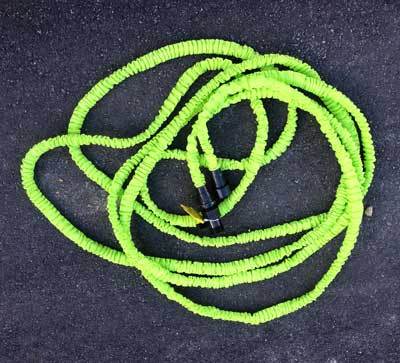
Expandable hose that hasn’t properly contracted after use.
You’ve probably seen ads on TV for these scrunchie-like hoses that expand up to three times their length when filled with water. They’re very lightweight (usually around 1 lb) and usually come in bright colors. Most are ½ inch in diameter and have adequate water flow comparable to a regular garden hose of that diameter, but not what you’d get from a regular hose.
Although they do expand as advertised, over time expandable hoses tend to stop contracting properly, leaving you with a hose that’s difficult to coil or store. Be aware that when you open the nozzle after the hose is expanded it will shrink (sometimes dramatically) as the water pressure in the hose decreases.
And if you have high water pressure or leave the full hose in the sun, expandable hoses are prone to rupturing because of the thin (non-reinforced) and highly flexible inner tube.
Having said that, many people do like expandable hoses because of the light weight. They’re best stored out of the sun, treated gently (they usually have crack-prone plastic couplings, although some of the hoses listed below have brass couplings), and used for hand watering, rather than being hooked up to a sprinkler or soaker hose. And be prepared to replace your hose frequently…
Some of the better expandable hoses are listed below.
 TeleBrands 7809 Pocket Hose Ultra 3x Stronger , 50 feet
TeleBrands 7809 Pocket Hose Ultra 3x Stronger , 50 feet
>> This is the one you most often see on TV.
 Ohuhu® Expandable Hose, 50 ft with All Brass Connector & Free 8-pattern Spray Nozzle, Green
Ohuhu® Expandable Hose, 50 ft with All Brass Connector & Free 8-pattern Spray Nozzle, Green
>> Probably the best of the bunch. Solid brass connectors and an 8-pattern spray nozzle is included. 17′ when contracted. >> READ OUR REVIEW
 Flex Hose 50 ft Expanding Hose
Flex Hose 50 ft Expanding Hose
>> Comes with a 7-pattern hose nozzle and a storage bag.
Now over to you – Which garden hoses have you used? What did you like? Not like? Let us know in the comments below!
And if you liked this review, please sign up for our monthly newsletter to get new reviews, special offers and giveaways.
Yes, I want reviews & special offers!
Please note that the links above are Amazon affiliate links. Should you choose to purchase through these links, GPR will make a small commission (at no extra cost to you) that helps to support this website and our gardening product reviews.